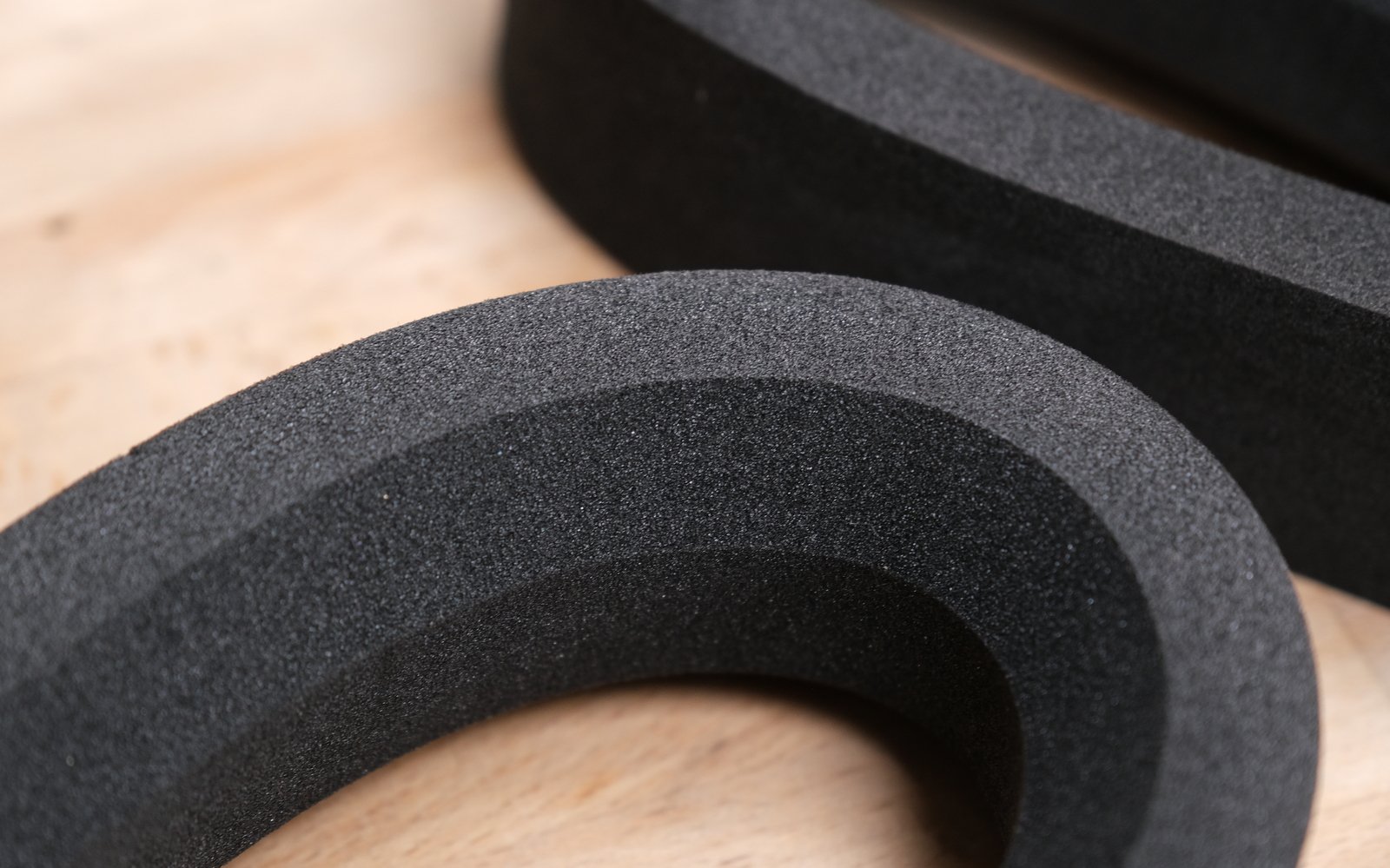
insert Review
Rimpact and Rimpact Pro Insert Review
Dave's Insert Virgin Rimpact Impressions
If you're a mountain biker and you know how to read, chances are you've heard about inserts and thought about using them. In theory, they sound great! Who wouldn't want more traction and improved reliability? It actually seems a bit odd that I/you/we have held out this long. How could this be? Well, if you're like me, and you haven't progressed beyond the "thinking about it" stage, there's probably a few reasons for this.
1 - They sound heavy
2 - They're expensive
3 - They're a pain in the ass to install
4 - Do they even do anything?
So, for all the other cheap, lazy sceptics out there, I'm going to have a look at these things through those lenses, talk a bit about my experience riding them, and then hand them over to Cam to talk comparisons with other inserts.
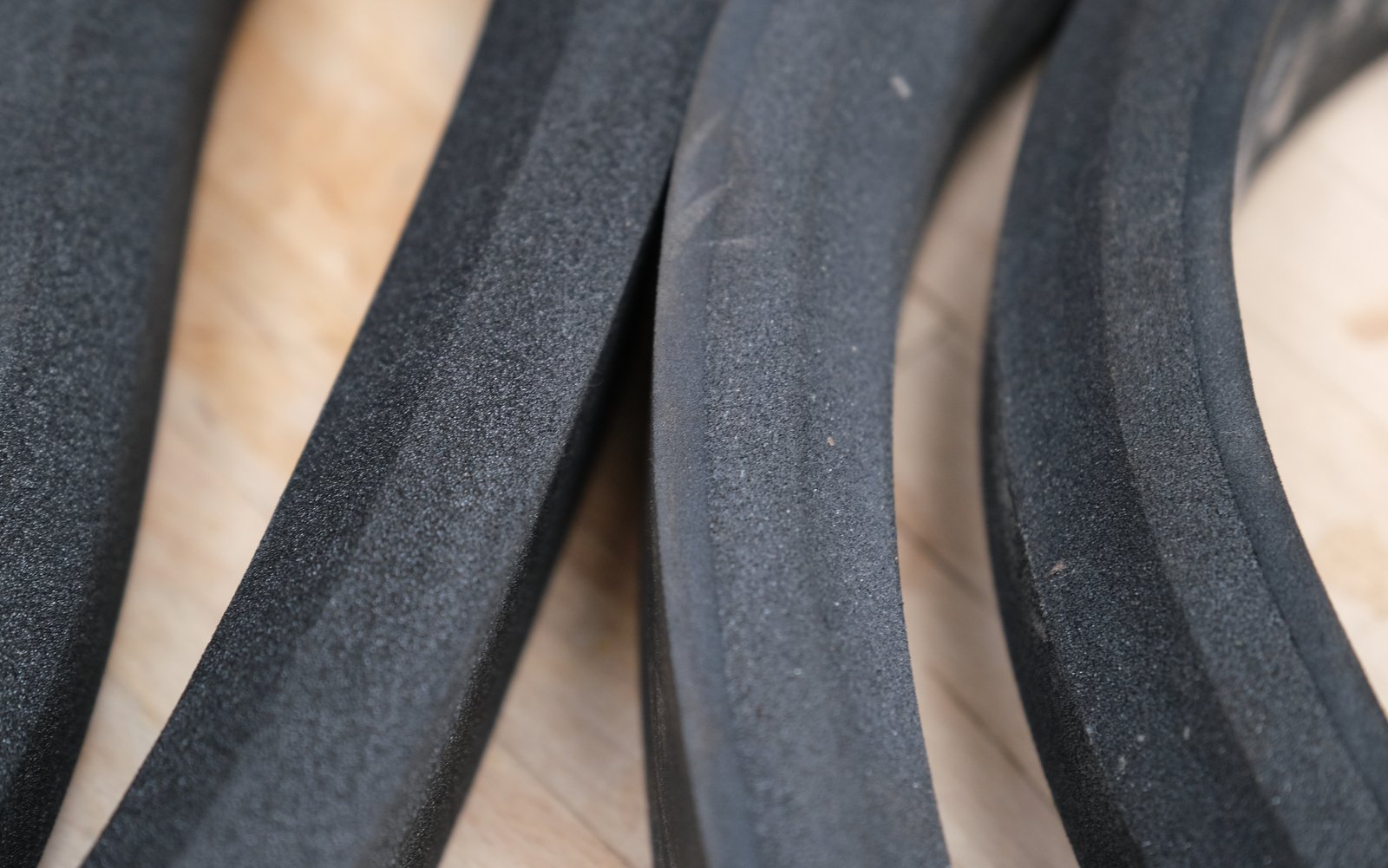
Possibly the most boring bike photograph I've ever taken. Standard Rimpact on the left and the dual compound Pro on the right. The Pro adds a layer of higher density material around the top which improves protection and adds a bit of weight.
They sound heavy
If the recent US election has taught us anything, it's the value of framing. Just by sheer repetition, certain factions of the American power structure have convinced a great many people that rampant electoral fraud has taken place. I would argue that a similar, yet less consequential, thing has happened with regards to tire inserts. Every single review talks about the weight of these things and it becomes this idea that hangs around in your mind.
Tire inserts are heavy.
And that is the first thing that struck me about the Rimpacts when I picked one up and started fondling it. These things are not heavy.
If you want to get scientific about it, using my own scale the weights I found for the Original (single material) version were 106.0 grams (29er) and the Pro (dual material) version were 157.0 grams (also 29er). Those values don't mean a whole lot to me, but in holding one in my hand I am confident in saying that it feels inconsequential. For shits and giggles I put a standard 650b rubber tube that was sitting here in front of me on a scale and it tells me that weighs 267.0 grams. So, both rimpacts weigh about the same as one shitty tube.
They're expensive
Nobody walks around arguing that CAD$200+ for some valves and a couple of hunks of foam is a "good deal". Ya, I know, I know. It's not that simple. A lot of thought and design and tooling and fancy material science goes into all of these hunks of foam that we put in our tires. But two-hundred-plus bucks! Come on!
The good news is that Rimpact goes some of the way towards bringing these costs down to something that feels a bit more manageable. You can head to their website and order:
- 2 Rimpacts with valves for 38 pounds (CAD$65)
- 2 Rimpact Pros with valves for 70 pounds (CAD$120)
- A mixed set of a standard (front) and pro (rear) for 55 pounds (CAD$95)
That's not "cheap", but it's also not 200+ bucks, and it definitely brings the insert experience down to a level where I'm comfortable writing the cost off as an experiment.
They're a pain in the ass to install
As an insert noob, this is probably what has held me back the longest. Do I really want to monkey around, wrestling a pool noodle onto my rims when I'm just going to have to yank them out in a month when a test bike goes back? No, no I don't. But, once again, it seems like we've allowed the narrative to overwhelm reality.
Rimpact has a good how-to that shows just how easy it is to install their product. I read through that a few times, and then proceeded to do things totally differently. I think their instructions would work quite well for a new install, but with a used tire and a bunch of sealant that I didn't want to deal with, not so much. So I forged my own path and it added about 5 minutes each tire to my usual tubeless install.
1 - Pop a bead off. I tend to go for disc side as it makes step 6 easier.
2 - Don't forget to swap in your new insert compatible tubeless valves.
3 - Start feeding your Rimpact in like you would a tube. Work it into place into the tire, on top of the rim as best you can. Here's where I started to deviate from the Rimpact instructions as there was no way I was getting that sucker fully onto the rim at this point.
4 - Once you have as much of the Rimpact on your rim as you can, start closing up the tire behind it. Feed the tire bead over your rim and tuck it down into the bottom of the rim as best you can. You'll probably get about 2/3rd around, with equal parts of the Rimpact and tire bead hanging out.
5 - Rotate the closed up portion of your tire down to the bottom so that all your sealant pools down there, out of your way. Now that the bead is holding 2/3 (or so) of the Rimpact in place, it's much easier to force the rest of it into place on the rim. So do that.
6 - This is a bit of a tricky part, but it's not too bad. Make sure that your installed bead is sitting as far into the center of the rim as possible so that you have as much bead slack as is feasible. Now, put the wheel, axle side down on something that isn't going to destroy your axle (or that your axle won't destroy) and start working as much of the bead on, from side to side, using your palms. You should be able to get it to around 75% with this technique. If not, no worries. It does get a bit tricky to slide the bead up and over the rim, between the Rimpact.
7 - Grab whatever crappy tire lever you have (I had some ancient Zefal's that sucked that I found in my toolbox). Hold one side of the bead in place with your hand, and then start levering over the other side of the bead with your other hand, a few inches at a time. Slide it under the exposed bead, hook it over the rim, and lever the bead over the rim, bit by bit. It shouldn't take more than 4 or 5 of these to get your bead over the rim entirely. You'll need to work the bead down between the tire and the Rimpact as you go, as well.
8 - Pump it up! You don't even need a sketchy fire extinguisher tubeless inflator. The Rimpact holds your beads in place well enough that I found I could just pump the tire up (with haste, though).
Easy peasy.
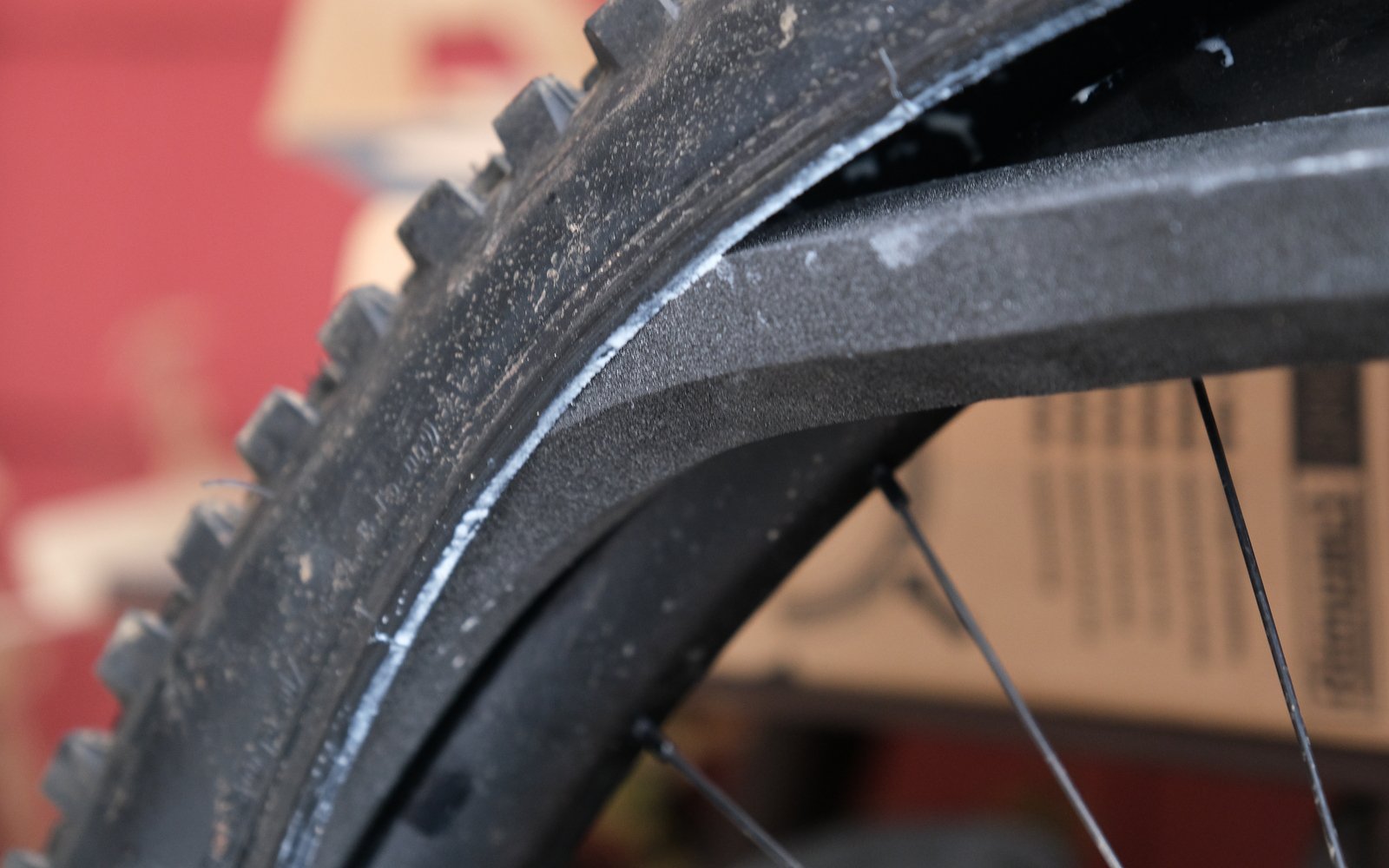
The crux move for Rimpact installation. Once you are here, you should be able to push the Rimpact onto your rim, and then (with a bit more difficulty than usual) get the rest of the bead seated on the tire.
Interlude - On Tire Pressure
Is there anything more situational on bikes than tire pressure? Width, casing, conditions, rider weight and riding style all play into this, yet tire pressure discussions often take place as absolutes. I talk a bit about pressure below and for some, these pressures probably seem crazy low, but for others (Mr. McRae in particular) crazy high. My "standard" Exo+ North Shore pressure is around 22-23 psi front and 24-25 psi rear. This is not what I would run in a bike park, but for most North Shore riding I feel like this works pretty well. It's not foolproof. I do need to slow down through certain rocky sections if it looks like something that might blow up my rear wheel if I hit it too hard, but that feels like a reasonable compromise for me. We'll see if an insert changes this calculation.
Do they even do anything?
The question of the difference these make on a bike is a bit trickier than I was expecting. Based on some recent insert reviews, I was looking forward to a night and day difference. Indeed, they do feel "different", even when just piddling around in the parking lot, but less so than I expected. The sidewalls are definitely stiffer, and the tires respond like a much heavier tire (more than just the 100-150 grams you've actually added to each wheel), but if this was a blind test I wouldn't bet much money on my ability to spot the difference.
I had already begun the process of dropping my pressures for wet weather season over the last few rides (down to 20/22 psi front/rear). My first insert ride was on a very wet day, so a further 2 psi out of each tire (18/20 psi front/rear) was about as far as I was willing to go on the Assegai EXO+ Maxx Terra's that I was running.
This did feel softer than I was used to, but not overly so. The tire felt soft, but supported. Climbing the bike felt very similar to what I was used to. The added weight wasn't apparent, nor was the slightly softer tire. However, things started to change once the climb turned a bit gnarly. The Ibis Ripmo AF is a good climber, but even it will be challenged by steep, wet rocks and roots. Things seemed just a tiny bit stickier with my drop in pressure.
Heading down, once again, things didn't feel all that much different, but the proof was in the riding. I felt like I could easily lay the bike into a corner and have confidence that traction would show up. It also felt like the tire was much better at holding a line. I hit some tire polished roots and not much happened, so I started to experiment a bit with other lines across roots that I would normally have avoided. There was certainly more grip, and the tire felt like it wasn't getting bounced off line as easily. Once again, it wasn't a hugely different feeling, but it was a lot easier to push the tires into challenging situations and hold your confidence. The result was me feeling pretty damn great on the bike.
Initial Conclusions
So that, of course, is not a lot of information to draw too many conclusions about, but Cam is going to take it away now and talk about how these things faired in the long term, and to provide some comparisons to other options on the market. For me, I feel like the Rimpacts have been a nice, easy introduction to inserts. They don't cost a fortune. They don't way a tonne. They're not that difficult to install. And, they make my bike feel pretty good.
Cam's Insert Gigolo Rimpact Impressions
My title overstates things drastically, but I'm no virgin and I wouldn't call myself an expert. I have used both Cushcore models, both Tannus versions, both Rimpacts, and Huck Norris. I haven't used Vittoria or Flat Tire Defender II, but I'm interested in trying both. With Rimpact I did back to back testing with Cushcore Pro to distill my impressions.
Like Dave, I was impressed by the weight of Rimpact inserts; a little over 100g for the original and just shy of 160g for the Pro version in 29
". To put this in context, the last Cushcore 29" I weighed was 280g. Like Dave, I used an original Rimpact up front and the Pro in the rear for a total of 260g or so.
My no-insert pressure riding on the North Shore, riding EXO level tires up to 2.5", is generally 19 front and 21 rear. For Cushcore I generally drop 4 PSI to 15 and 17, without any problems thus far. Like Dave, if I was riding elsewhere, like the Whistler Bike Park, I'd certainly be running higher pressures, but the steep and technical terrain we ride generally keeps speeds down and traction is a huge priority, particularly this time of year.
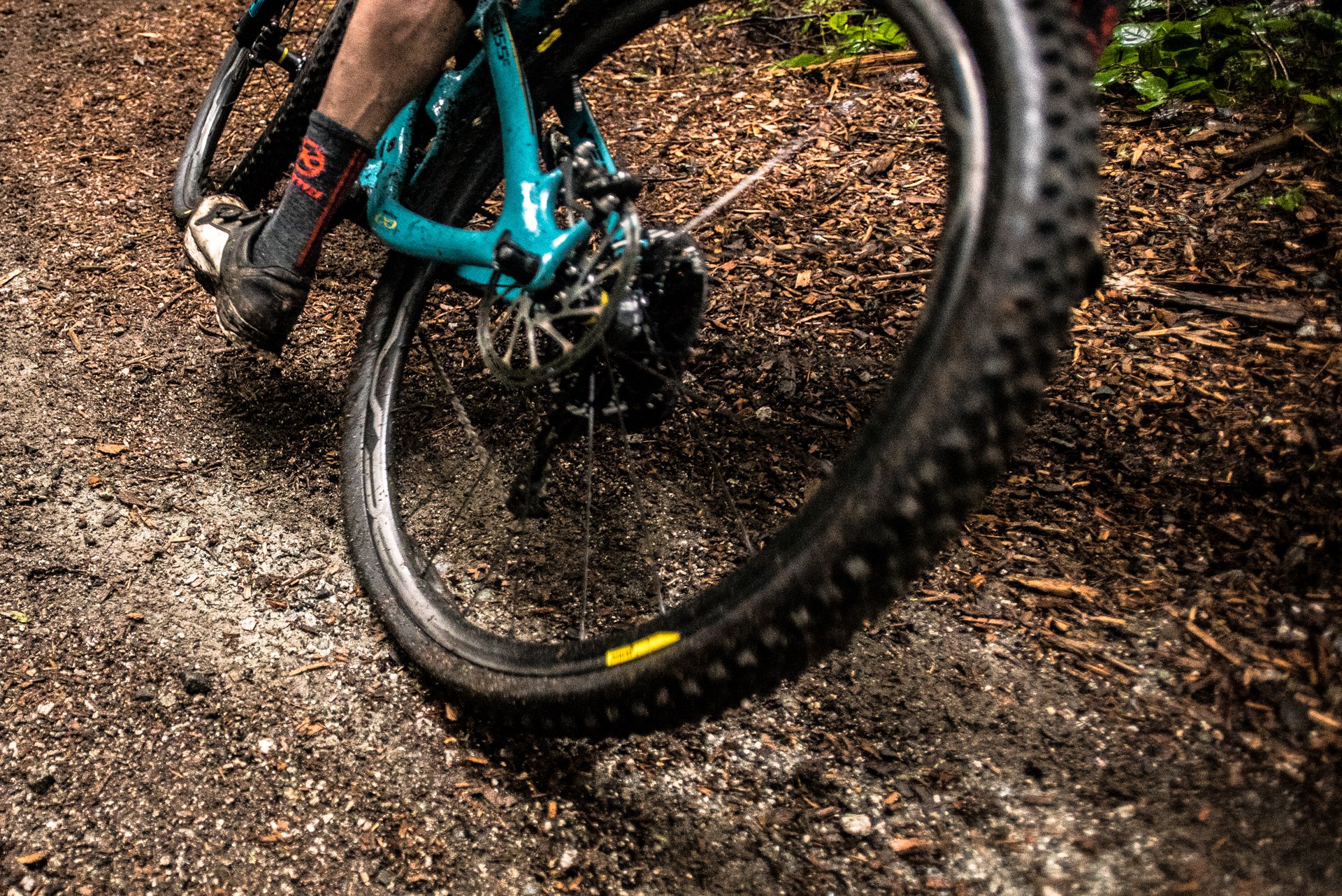
I tried cornering with light and flimsy tires no pressure at all with Cushcore and it was surprisingly effective. There was a little squirm and I couldn't go full speed, but I could certainly go. I've yet to encounter an insert that has the run-flat capability of Cushcore, but Rimpact is likely quite capable because it occupies a lot of volume. Photo - Dave Smith
I started out using similar pressures with Rimpact inserts, but soon found it wasn't enough. I bottomed out the rear wheel once, enough to make the sickening clang that indicates you'd better check for damage,* before raising the pressure 2 psi. Unlike Dave, and perhaps because I was on a hardtail, I could notice some damping and cushioning from the Rimpacts. It was less than I was used to with Cushcore but still beneficial.
*dodged a bullet this time
Another difference between the two was sidewall support. This is one of the most noticeable aspects of Cushcore at lower pressures, and in fact enough support remains to corner relatively well if you happen to get a puncture. Again, unlike Dave, I didn't notice much cornering support but it could be that my expectations were elevated because I was expecting closer to the support of Cushcore or Tannus Tubeless.
It seems to me the lack of sidewall support is related to Rimpact's squared off anvil shape. The profile doesn't allow the insert to press against the sidewall as you move away from the rim nearly as far as Cushcore or Tannus Tubeless. I suspect this is because the low density material wouldn't withstand impacts well if it had wings that became thinner as they extend out at 45º. For me this is a big miss.
When I installed Cushcore on the Honzo ESD, the bike came alive. It wasn't as hard on my body and I was confidently smashing into sections where I'd been hesitant previously, and the change made hardtailing much more pleasant and fun.
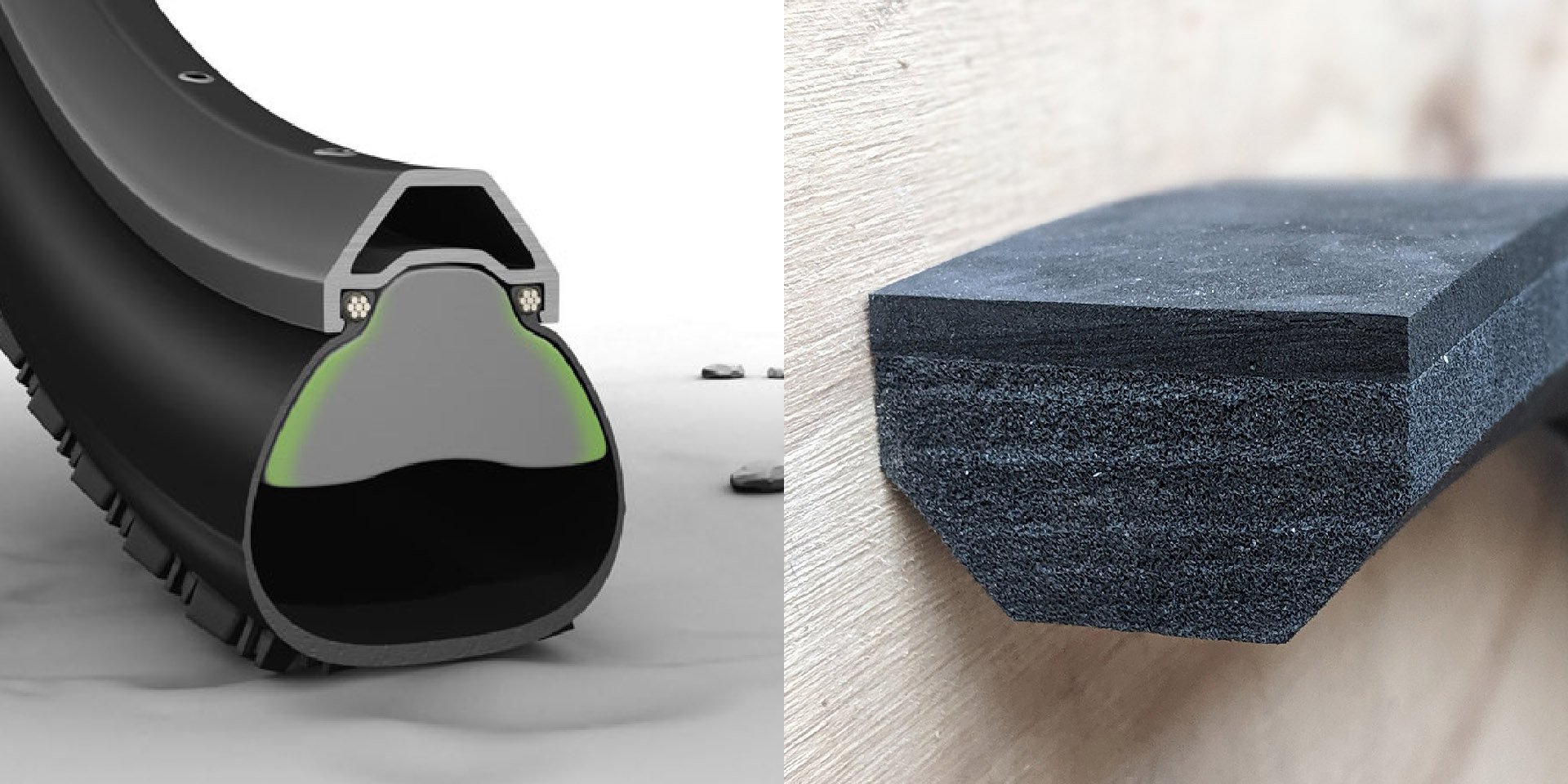
My supposition is that the difference in profile is responsible for the difference in sidewall support between Rimpact (right) and Cushcore (left). Cushcore does a great job supporting the sidewall with very low pressures and a serviceable job even when the tire is flat while Rimpact doesn't offer significant sidewall support.
Despite these observations, there are some upsides for Rimpact. If you are looking for puncture prevention and rim protection, rather than the increased low-pressure traction I prefer riding on the North Shore in the wet, using Rimpacts at closer to your usual pressure should deliver good results with a low weight penalty. I didn't try riding the Rimpacts flat but, because they occupy a decent amount of volume, I think they would be quite effective, at least in a straight line. My research tells me that, like Cushcore, Rimpact is a wear item that will sustain damage after hard impacts. I couldn't see any significant damage when I removed my pair after a few rides, but I've read reports of chunks split off the side after heavy impacts. Cushcore doesn't seem to lose chunks but impact damage will put holes right through the material where it contacts the rim over time. Thus far I haven't seen any damage to Tannus in similar circumstances, likely because it's hollow rather than a solid piece of foam like both Cushcore and Tannus.
Independent of cost, I'd choose either Tannus Tubeless or Cushcore ahead of Rimpact for my riding, but if your goals differ from mine, and low pressure damping, impact resistance and cornering support are lower on your list than puncture protection, modest rim protection, and weight reduction, Rimpact could be a good choice.
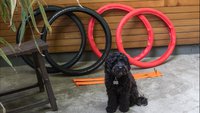
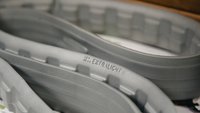

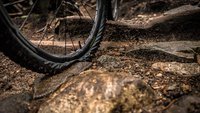







Comments
captainsl0w
3 years, 3 months ago
Good and informative review. Is there any chance of comparison with pepi's tire noodle r-evolution?
Reply
taprider
3 years, 3 months ago
I've been using Pepi's Rokline (the yellow Enduro ones) for two years with good results and wonder if the r-evolutions are as durable.
Even the heavier yellow Pepi's are far lighter than most of the competition, give good sidewall support that enables one to use narrower and lighter rims, so the overall system weight can be the same or lighter than no inserts
Reply
Randall Souza
2 years, 3 months ago
Hey I just purchased a pair of Pink Revolution's S/M 27.5's from LordGun got them in 3 days by FedX from Italy.
Little tough to install, but took less than an hour, probably would be quicker on the next one.
I just tried it out just on my rear tire only, it's a 27.5, Ibus 742 rim, Maxxis 2.3 Minion SS, on my older Yeti SB5C. With some of my stimulus dough I purchased Cane Creek Helm MKII 150mm fork. It was a tremendous improvement on the front end, but my 130 rear-end with my small 2.3 tire (only size that fits a 12 spd) Can't keep-up.
That is NO longer the case, Instant Improvement with the Pepis on the rear only ( Pressure change from 19.5 to 18.5psi)! My Yeti now runs straight & true like it's a new mid travel enduro bike. Much much more stable, more compliant on impact, with controlled rebound. It is a Total Dramatic improvement with smooth stable controlled handling everywhere.
It only weighed 75 grams! At $86.00 delivered for 2x liners & 2x Trick new valves & cores it is a pretty good deal for a XC, to an all mtn setup.
I'm sold, the best & lest amount of money I ever spent for biggest improvement in performance ever, WOW!
Reply
Cam McRae
3 years, 3 months ago
I'll put those on our radar and try to get a test organized. I hadn't heard of them previously but they look promising and even the largest version of the Revolution model apparently weighs 109g for 29er.
Thanks!
Reply
gregster77
3 years, 3 months ago
I'm so amazed when I hear about use of exo/exo+ tires here. I just do DD, never had a flat and tires never feel flimsy, and able to run about 18/20 PSI. I suspect this goes with me not being as good of a rider and picking my lines properly :D
Also I never paid too much attention to what grip people are wearing, but i always assumed maaxgrip at least for front, always. Given how wet our wet coast is, i kind of figured maaxgrip is just a requirement. I really try to avoid dragging my brakes, and maybe i'm not riding enough rocky terrain but been getting about ~800-1000km out of a maxxgrip on the back (running to bald tire!). I probably need to start riding more aggressively.
I guess inserts open up more options with grip rating to get longer lasting tire while getting grip via lower pressure. I assume you can still slice an exo the same way with or without an insert, but lesser chance of damage done via rim.
Reply
Cr4w
3 years, 3 months ago
Rider weight and riding style factor in hugely.
Reply
GreyHead
3 years, 3 months ago
Been using the rimpacts for a couple of months now, dropped pressures to 19/17 from 22/20 (minion/assegai) and am happy with the results on my HT. Also put them in my Dual suspension, 19/17 Eliminator/Butcher. No complaints. I can't compare to other inserts as these were my first venture into using inserts. I'd been put off by costs and weight.
Reply
Cam McRae
3 years, 3 months ago
Glad you've had success Grey. I'd be interested to see what they look like in terms of wear when you change tires or pull them for whatever reason.
Reply
LDG
3 years, 2 months ago
I've used Rimpact all of 2019 and Rimpact Pro all of 2020. The regular ones had a few cuts, or at least the one in the back wheel, nothing like a Huck Norris though so all good to continue to use. The Rimpact Pro in my back wheel didn't have any marks that would suggest that it needed changing, that was after about 500km, mostly enduro style riding.
I do think that all inserts I've tried except Cushcore pro needs to be wider for anything over 63mm casing tyres to still help against the tyre folding. For 2,4 and 2,5 tyres every insert that's 50mm or more helps. Some noodles are so light that they'll shrink a lot under the pressure we use in tyres so if you choose a light noodle, choose a big one, probably 60mm for a 2,4 tyre.
I used Pepis Revolution for 400km in the beginning of the season, no rim damage or puntures even if I rode hard with a Magic Mary snakeskin front and Bontrager XR5 in the back.
Reply
DG9180
3 years, 3 months ago
I’m running the Rimpac’s for almost two years now, only in the rear, with great results!
They don’t soak up sealant and look as good as new after two years, but I’m not running super low pressures. 21frt/25rear with EXO+. They give a nice damping to the ride witch I really like, and have more lateral suporte as well, and also saved my rims a few time.
Have some bodies that also have them and have no issues as well.
Seeing as it comes in packs of two, you can buy them with a friend and spilt the cost which makes them really accessible cost wise if you only want to run them in the back.
Would like to know if you felt any difference between the normal and pro version Rimpact’s.
Thanks.
Reply
fartymarty
3 years, 3 months ago
Cam - I'm an insert virgin and have only just moved to proper casing tyres. I ride in Surrey UK (no rocks, some roots and plenty of mud atm) and have previously got away with Exo F+R. I'm now on WTB Verdict LHG and Judge THG for winter which are properly heavy cf 2.5 exos. While I like the WTBs they're probably more tyre than I need.
Would your preference be to use a lighter casing + insert or just run a heavy casing? Weight wise im sure an insert isn't going to be heavier than the ~1400g Judge I have on the rear.
Thanks in advance, Martin
Reply
Humanpowered
3 years, 3 months ago
I would go with a lighter casing and insert. A lighter casing like EXO or EXO+ is more supple and able to better conform to the ground. With the insert, you can run lower pressures, protect your rims and keep the advantages of the supple casing.
Reply
Mammal
3 years, 3 months ago
Agreed, based on my experience with Tannus. I'm running regular EXO with the fairly pedestrian Maxterra compound, and the support, flat protection and traction with the lower pressures has been huge over the winter (Shore riding).
Reply
Cam McRae
3 years, 3 months ago
Hey Martin. There are lots of factors to consider here, including rider weight and how hard you are generally on wheels and tires and of course your terrain. For the kind of riding I do at my current 160 lbs I prefer the feel and performance of an EXO or EXO+ level tire, perhaps at 2.5 and sometimes 2.6, with an insert to a DH casing tire, and I can generally accomplish this at a lower weight than many DH casing tires.
AJ's article comparing inserts to heavier casings might prove useful as well. https://nsmb.com/articles/cushcore-preferable-heavier-tire-casing/
This is a very personal choice even when riders are similar in terms of the variables to be considered so it's a tricky question to answer for someone else who is riding different terrain. One thing that is comparable though is weather, and I like having more grip on roots and rocks and I find lower pressures more with inserts more beneficial than Maxxterra compound (as an example). But our riding always involves lots of rocks and roots and yours does not. Wouldn't it be great if it was possible to try these without dropping all that cash?
Were you having problems with lighter tires before you went to DH casings?
Reply
fartymarty
3 years, 3 months ago
Cam, thanks for your reply.
I wasn't having any problems with lighter casings except maybe lack of grip in the winter slop from the DHF / DHR2 combo. I run MG front and MT rear on Maxxis. The Judge / Verdict combo is a lot better for grip and I would love these in a lighter casing.
I need to re-read AJs article. Maybe a lighter casing + insert is the answer.
It would be great to be able to try before you buy. Maybe this is something I need to speak to my riding buddies about and split the cost.
Reply
Ryan Walters
3 years, 3 months ago
Gonna chime in here with my experience.
I'm definitely in the "run lighter casing tires with inserts" camp. Before I started using inserts, I was pretty much relegated to DH casing tires - for the sidewall strength, and for the snakebite resistance against rim strikes. With inserts I can get away with EXO sidewalls, and my rims don't see rock strikes anymore. I personally wouldn't go with an insert that didn't provide good sidewall support, meaning I don't think the Rimpact would work for me.
For the record, I'm currently running Tannus Tubeless Armour inserts with EXO+ casings (Assegai MaxxGrip-21psi up front, DHR2 MaxxTerra-22psi in back). This setup is as close to perfect as I've found to my riding style. The EXO+ and Tannus inserts probably weigh the same as DH casings alone.
My take on inserts is they are one of those things you didn't realize you needed until you've tried the right ones. I can't imagine riding without them now.
Reply
fartymarty
3 years, 3 months ago
Thanks all, lots of food for thought.
Reply
Cam McRae
3 years, 2 months ago
This is a ringing endorsement because Ryan rides very hard and is a sturdy lad to boot. I've wondered about riders who are heavier and ride more aggressively than me having a similar experience and this answers that question.
Reply
Timer
3 years, 3 months ago
I don’t think I quite understand which problem you are trying to solve with the inserts? Are you looking for a lighter alternative to the verdict and Judge with similar grip? Or did you like the Minions but they were too fragile at low pressure?
Reply
fartymarty
3 years, 3 months ago
I'm after a lighter alternative to the V/J but with similar grip. Minions are good but don't have as much grip.
I'm trying to find the holy grail of tyres - light, grippy, puncture resistant, good support and fast rolling... and tyres I can leave on all year.
Reply
Timer
3 years, 2 months ago
Hm, tricky. Did you try the Continental Baron? Ticks most of the boxes. Much grippier than Terra minions, very supportive sidewalls, rolls decently, light enough that you can add inserts to taste without it becoming boat anchors.
Reply
fartymarty
3 years, 2 months ago
I haven't but thanks for the tip. Will research further. Do you run them F+R?
Reply
Timer
3 years, 2 months ago
Front only for me, but plenty of people run them on both ends.
Mammal
3 years, 3 months ago
I'm not sure if you guys have been running these for long enough, or swapped tires around, but any feedback on whether these things soak up sealant, or get bunged up over time?
This is something I've been really impressed with for Tannus. They still look and feel like new after taking tonnes of abuse.
Reply
AndrewR
3 years, 3 months ago
IMHO the single most glaring statement relating to winter riding, in this article, is: "on the Assegai EXO+ Maxx Terra's that I was running."
If I felt that Maxxis was a food group I wanted to sample I would certainly be choosing the Maxx Grip flavour for autumn/ winter/ early spring (in fact all the time - $10 more for a tyre that actually grips is more important that a tyre that rolls a little faster and might last a little longer) over the Maxx Terra that might still have useable side knobs whilst I am healing up from that crash related injury.
Good chat about inserts. I am looking forward to trying the Tannus tubeless.
Happy trails
Reply
Cam McRae
3 years, 3 months ago
MaxxTerras are actually just fine with the inserts I've used - any time of year. There's also some uncertainty about how soft MaxxTerra remains when temps drop below 7º Celsius. Without inserts softer rubber is much more vital, but with them I have run some hard, crappy, flimsy tires with excellent results. The difference is that dramatic.
Reply
fartymarty
3 years, 3 months ago
Cam - is this with Tannus or CC or both?
Reply
Cam McRae
3 years, 2 months ago
Both. In terms of low pressure performance I'd say they are very similar but Cushcore has a more distinct damped feel that I really appreciate, particularly on the hardtail. I've used some terrible tires (poor casings, hard compounds and small knobs) with Cushcore and achieved remarkable results.
Reply
Mammal
3 years, 2 months ago
I've found the same thing with Tannus X MaxTerra. All the traction over wet roots and slippery off camber rock, from November to present.
I get what AndrewR is getting at, but I no longer have a need to run MaxGrip after going Tannus. Decreased wear and being able to swap front/back is a key value proposition.
Reply
Dave Tolnai
3 years, 3 months ago
Not many tests bikes show up with maxxgrip. I actually did have a maxxgrip that I could have swapped to the front, but wanted to keep it apples to apples. If I was buying new, of course I would try to go maxxgrip up front. But at the same time, I’ve been doing a lot of wet riding lately, and I have pretty good confidence on maxxterra with an insert.
Reply
Lynx .
3 years, 3 months ago
Ah sweet, just the article i was looking for. Cam, since you were on a HT, you're the man to ask moreso I guess, but how did the effect the dampening/bounce of the ride? I haven't had issues of needing an insert for the riding I do or pressures I run, have been very happy, where I am not as happy is on the rigid running 3.0" tyres at proper low pressures and the ball bounce effect off roots and rocks you encounter and ma looking for something to help add some dampening to that so you're not slowly getting bounced off to the side of the trail on rocky/rooty off camber sections heading towards large trees that would hurt. This is on faster type trails, when speed is slower, not really an issue.
Reply
Cam McRae
3 years, 3 months ago
3 inch tires add an element I haven't yet experienced with inserts, but Andrew Major has and has written about Cushcore plus model. https://nsmb.com/articles/cushcore-29-plus-inserts-much-more-good-thing/
If you are getting the basketball effect, could it be that you are running too much pressure? In my experience on plus tires or even fat bike rubber, the key was finding the pressure that gave enough support without getting that bounce. I've been able to do so riding on the Shore but something we don't deal with much is intense cornering where tire deflection or roll becomes a problem. f you need more cornering support then Cushcore + might be the way forward so you can lower pressure without much compromise. Except weight!
How much pressure have you been running and what has kept you from going lower?
Reply
Lynx .
3 years, 3 months ago
Thanks for the reply Cam. Yeah I saw Andrew's take on them, but the weight coupled with plus tyres adds up to a lot if you like long pedals. As to pressures and tyres - I'm running Maxxis EXO/TR Chronicle rear/DHF front and on slower trails I can drop between 10-11 PSI on the front and 12-13 in the rear, this according to my Topeak digital gauge - it doesn't show to the decimal place, so not really accurate enough for plus. If I run these pressures on faster trails, when I encounter any unexpected sharp rocks or deep roots, it's a rim strike for sure. On faster trails, I have to bump it up to 11+ front/13+ rear or I also experience a bit of squirm and yes, I know the i35 outback might be part of the cause since the rear suffers most, but it was an experiment and I honestly did not notice a huge difference going from a matching Dually i39.
I weigh about 185-190lbs kitted to ride and the bike weighs about 32.5-33lbs IIRC, running an i39 Dually front/i35 e13 TRS rear and thankfully they've held up really well when I was finding out how low I could go or mixed trail types up on a very long ride. I also run a set of WTB Asym i35 wheels shod with Schwalbe 29x2.6" for more XC stuff, but which are proving to be not too bad cush wise, so also thinking of doing something along that line and sticking with 2.6-2.8" tyres instead of 3.0" when I replace my now over 4 year old Maxxis setup.
Naturally I try to ride as light as possible being it's a rigid, but you get caught out sometimes and you just can't avoid the hit. The specific trail where I first realised this effect is a fairly fast and smooth trail, with some short, steep downs, but those short steep downs, generally have some roots running not perfectly across them, some are off camber and longer and that's where I noticed the feeling of being pushed off the side of the trail.
Reply
jdt
3 years, 3 months ago
Clearly, the ideal insert would be light as Rimpact, but offer ease of installation and the performance obtained from the Tannus or Cushcore. Do you think there is room in the R&D development curve to achieve these goals? Or, do you think there are inherent limits to the tire-insert concept that will continue to force riders to pick between light and limited performance vs heavy and better performance?
Reply
mtmc99
3 years, 3 months ago
It seems like it would be tough to achieve all 3 simultaneously. To get the increased side wall support it seems like the insert will always need to be a tight fit which is what makes installation hard.
It seems like a less dense foam could be developed to give similar performance but Im not sure what sort of tradeoffs that would involve (sky high cost for a wonder material, or decreased life span).
Reply
Vik Banerjee
3 years, 3 months ago
Tannus' new inserts give good sidewall support and are easy to install and light. The only downside I can see is they don't run flat as well as an insert like CC Pro.
Reply
Cam McRae
3 years, 3 months ago
For me Tannus hits that sweet spot at the moment with lots of benefits at 160 grams or so in 29. It makes me wonder if it would be possible to create an insert with a sealed air pocket, like Procore but not adjustable, within an insert to remove material without adding weight. Perhaps a material like that used on Tubolito tubes might work? I'm sure we'll see more innovation in this space considering how far we've come in such a short time.
Sterling (I said Coleman earlier but it was Sterling who also does work for the company) from Tannus has also been experimenting with putting more holes in the insert to further reduce weight by 30-40g and he says he hasn't experienced a drop in performance, which I find surprising. I also believe he rides in a much drier and rockier zone and is an aggressive DH riders so he's likely running a lot more pressure, but I'll have to confirm that.
I'm also curious about Pepi's Tire Noodle - at least the Revolution model - now that it's on my radar thanks to Cap'n Slow and Taprider above. Also the new Fat Tire Defender 2 looks very good, but there is no info on how much it weighs on the website.
In terms of installation, Cushcore's bead dropper and a little experience dramatically improve the process. I hardly dread installing Cushcore these days! And the tool makes installing all the others much easier as well. Here's Andrew Major's review https://nsmb.com/articles/cushcore-bead-dropper-tire-lever/
Reply
Mammal
3 years, 3 months ago
Where is Coleman removing the material from? In the center, effectively making more "air transfer ports"?
Reply
Cam McRae
3 years, 3 months ago
I've asked for more info. Stay tuned.
Reply
taprider
3 years, 3 months ago
The Rokkline have a shiny yellow armour around the lighter core of the noodle. The Revolution do not appear to be armoured and I wonder how much sealant they can soak up? (weight them before and after use?)
The Rokklines might be more similar to ProCore than to other inserts?
Reply
Dave Tolnai
3 years, 2 months ago
An update. I just installed a used Rimpact on the front of a different bike. Installation was even easier than the first time around...aside from the odd, gloopy pink sealant in the tire. I was almost able to do it just with my hands. I needed a standard tire lever for the last 3-4 inches of bead, but barely. Here was my process:
- Bead off 1 side of tire, push the Rimpact all the way on to the rim - this was the first big difference - I couldn't get a brand new Rimpact seated all the way around with the bead in place on 1 side - but the used one went right on
- Start pushing your exposed bead onto the rim - the rimpact actually holds it in place, so this is no more difficult than with no insert, just a bit different.
- Once you get to the last 4-5 inches, it gets difficult, just like with a regular tire. Push the bead that is already on the rim all the way down into the center of the rim to give yourself as much slack as possible, then either push the remaining bead on, or lever it over with a tire lever
Really, with a used rimpact that has stretched out a bit (I think that's the only difference) it becomes really trivial to install, as it was super easy to get it seated on top of the rim, and the whole process isn't much different than a regular tubeless install...except...just pump it up like normal. The Rimpact holds the beads in place, so no high pressure required.
As well, I only had a stock valve, so I just took a file and cut a groove down the middle of it, and this seemed to be enough to allow the air to get in under the rimpact.
Reply
John Williamson
3 years, 1 month ago
So I have a couple of rides with the Dual RimPact in the rear (29x2.35 Aggressor) and it started squeaking like crazy! At first thought it was a frame issue, but no, it’s coming from the tire. Anyone else? Running around 20 psi with Orange Seal Endurance.
Reply
Cam McRae
2 years, 4 months ago
That's a weird one. I haven't heard that before.
Reply
John Williamson
2 years, 4 months ago
I removed the “Pro”, and replaced it with the standard Rimpact insert and no more squeaks. Rimpact was great about their warranty.
Reply
Please log in to leave a comment.